20 Devices and Machinery in the Medical Field
Parker Schwan
20.1 Introduction
Keywords
- X-ray – penetrating form of high-energy electromagnetic radiation in order to get images of someone’s bones or body
- Computed Tomography Scans – a series of x-ray imaging from different angles of the body and computer processing in order to get images of bones, tissues, and blood vessels inside the body
- Magnetic Resonance Imaging – the use of strong magnetic fields and radio waves in order to generate images of different organs and ligaments in the body
- Electrocardiogram – a test that is used to check someone’s heart rhythms and electrical activity by using sensors attached to the patient
Learning Objectives
- Differentiate between the different types of medical machinery and what they do
- How medical machinery has been upgraded in recent years
- What medical technology has done to change lives
- What medical technology has done to improve research
- What the future of medical technology looks like
Machinery in the medical field has upgraded tremendously in recent decades. Some hospitals have gone from surgery being conducted only by hand while other hospitals have switched to partially robotic surgery. The advancements of certain technology in the medical field have also affected medical research significantly. Machines such as X-Rays, CAT scans, MRI scans, and other different technology advancements have made it possible to figure out what exactly a certain injury in someone is as well. 3D printing has also helped hospitals supply certain organs for people who need organ transplants since they cannot afford real transplants. These advancements have also made lab work much easier than it has been in recent history. Vaccines have been able to be developed from different machines and also cures to some diseases have been acquired from different machinery. Technology in the medical industry has changed many lives in an unbelievable way and has also advanced medical research tremendously.
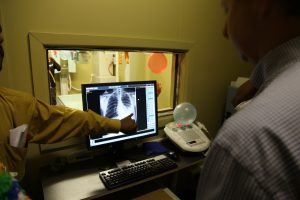
“X-ray machine at Daru Hospital is able to take digital images and send them via email” by DFAT photo library is licensed under CC BY 2.0
20.2 Different Machinery in the Medical Field
Key Takeaway
Many different machines have been invented and have influenced the medical field in recent years. One major invention was the X-Ray which is the machine that takes pictures of the bones in your body, which tells the doctors if there is a fracture or break of certain bones. This machine can be used in small injuries such as a hairline fracture in a finger to major injuries such as a broken femur bone. Before x-ray imaging was invented, doctors had to use physical examination and straight-up guess if the bone was broken with the naked eye. These machines have taken the stress off all the doctors and made it easier to examine bones.
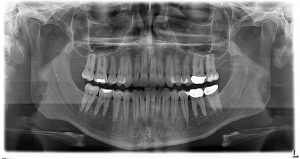
“X10068 – panorex – Dentist Visit Teeth x-ray” by akeg is licensed under CC BY-SA 2.0
A computed tomography scan (CT scan) is a diagnostic tool that is used to detect certain diseases and injuries. These are mainly used when a doctor is looking for certain diseases such as cancer, heart disease, and many different medical conditions. They are also used for complex fractures and different joint problems. People tend to mistake CT scans for Magnetic Resonance Imaging (MRI Scan), but an MRI scan is a type of machine that uses a massive magnet and radio waves in order to look at different organs and structures inside the body. This type of machinery is typically used on someone who needs examining on their brain or their spinal cord. MRI scans are also used widely in sports because players will tend to get an MRI if they believe they have a torn ligament such as an ACL or MCL. The main difference between the CT scan and MRI scan is that CT scans use x-ray imaging from different angles of your body to get results while the MRI scan uses magnetic and radio waves to get results.
Electrocardiograms (ECG) are also used often in hospitals. These machines are used to evaluate someone’s heart rhythm and also the heart’s electrical activity. Different sensors that are attached to the ECG monitor are placed on the patient’s skin that reads the heartbeat of the patient and detects the electrical signals produced by the heart. The heartbeat is then shown on a graph connected to a machine so that the doctors can evaluate the heartbeat and signal that the heart is giving off. This is one of the easiest machines to work and read for a doctor.
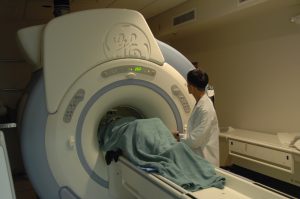
“MRI machine with patient” by National Institutes of Health (NIH) is marked with CC PDM 1.0
20.3 History of Medical Devices
Key Takeaway
The 19th century is seen to be one of the greatest advancements in medical technology. One of the most major advancements in this century was the invention of the stethoscope. This tool is used to listen to the heartbeat of a patient and even to listen to lungs. Prior to this innovation, Doctors mostly had to rely on the stories that the patients told and the visual inspection of the patient’s body. Now, doctors can listen to the heart, this gives them more information about what could possibly be a certain condition the patient is dealing with. It ultimately reduced the significance of the patient’s story and the doctors learned to rely on what they could hear themselves through stethoscopes. Another massive invention in the 19th century was the clinical thermometer. This made it possible for doctors to get the temperature which would help them determine what sickness they possibly had.
Mechanical robots were invented in the late 1980s but were not actually introduced into the medical field until the 1990s. These certain robots were invented to be used in certain surgeries and also used for different things such as brain biopsies. These robots have been proven to be very helpful in certain surgeries and situations in the medical field. Laparoscopic surgery is a surgery that robotic devices have been used in all the time. There is a robotic arm that is synced up with a monitor that the doctor controls and the small arm goes through a small incision on the patient in order to get a view of the body. The doctor then controls the arm to make the certain cuts needed. These are mainly used when it is simple to make too big of a cut so they use small robotic arms in order to be safe and not risk the life of the patient.
Different robots have been invented recently to monitor certain patients that may have infections or different illnesses. The robots use non-contact methods such as using infrared light in order to read the patient’s body temperature. The robot is also able to take pictures of the patients so that the doctors can read the images of them and determine what is wrong. The robots are present to people who are in quarantine because they do not want to spread the virus or whatever illness they have and if the patient is in need of an urgent request, the robot can call the doctor and the patient can speak directly to the doctor.
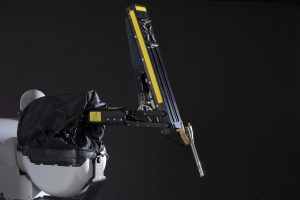
“Patient side cart, from da Vinci® Classic surgical system (robotic surgery unit)” is licensed under CC BY-NC-SA 4.0
20.4 Impact of Medical Devices on Society
Key Takeaway
Society has been greatly impacted as a whole by the different inventions of new medical technology. The new inventions have given doctors more clarity and made them more confident in what they diagnose. These machines have also given the evidence that they can prove to the patients instead of them having to go off a gut feeling and the naked eye, they have proof with pictures. The inventions have also made it so that there are better treatment options in hospitals and urgent care. This can be from the new inventions of a drug that can treat certain illnesses and better living conditions in the hospitals. The inventions have also given doctors the ability to research certain diseases and illnesses so that one day they can maybe form a cure for diseases like cancer or Alzheimers.
Society has also been greatly impacted by the advancements in technology because these inventions have saved many lives. This ultimately has increased the life expectancy for many people because if we did not have the machines used to find certain illnesses, doctors would never know how to treat someone. The increase in life expectancy has also made it so that certain people with jobs can work those jobs for a longer period of time. This all impacts the economy greatly. Inventions of new drugs through research has also been shown to be of great use because people have been cured of many diseases. This makes it so that they can live out their lives without the worry of suddenly passing which takes off the stress of many individuals.
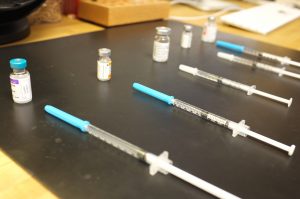
“Loaded up w/ Medical Technology” by lhl is licensed under CC BY-NC-SA 2.0
20.5 Future of Medical Technology
Key Takeaway
The future of medical technology is bright, but there can be some things to keep an eye on. Some medical jobs may be taken in the near future by certain machines taking over the medical realm.
The future of medical technology is amazing for society and also for hospitals. Different advancements have come into the picture recently and one of those is the use of virtual reality in the medical field. Virtual reality is used widely in medical school for students to learn the anatomy of the body and to also learn about certain diseases up close. It is also used for treating certain patients in physical therapy. Another medical advancement that is looking bright in the future is prosthetic limbs. These devices are always being improved and improvised so that it fits the patient perfectly. Research is continuously being conducted to improve these devices. 3D printing has also taken a step into the medical field and improved some of the little things. Certain drugs have been improved to be 3D printed and this makes the pill dissolve faster in the body ultimately putting the drug to work faster. Some companies are also 3D printing some pills in different shapes so that it is easier for kids to swallow the pills.
Jobs may also be taken from too much advancement of technology in the medical field as well. Certain robotic advancements have been proven to be more reliable than the naked eye in some situations. So these hospitals have turned from using doctors to using robots for certain procedures instead. Robots have also been shown to be cheaper over time than having a human on a salary. Businesses may look at this as a business move and move more towards robotic advancements instead of hiring certain people for jobs. The way the government and certain companies look at it is “why would I hire a person for the job when a robot is more reliable and also cheaper than a human?”. This will cripple many blue-collar jobs such as surgeons and could hurt the medical field for job openings. Something about having a doctor perform complicated surgeries is also better though because if a robot has a malfunction, it could possibly end someone’s life. But overall, the future of medical technology is in the right hands and is moving in the right direction.
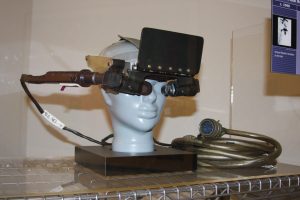
“Virtual Reality Headset Prototype” by Pargon is licensed under CC BY 2.0
Case Study: Patients INjecting Medicine Themselves
Chapter Summary
Medical technology advancements have greatly impacted the world in recent years with the inventions of different machines. These machines have saved many lives and helped the doctors find out what is wrong with the patients. Certain injuries require deep scanning and images to find out what has happened to someone and these machines have solved the problem for doctors. The future advancements also look bright for the world. The advancements range from robots performing certain surgeries to companies 3D printing pills so that it is easier for kids to take the pills. Life is better for the doctors and patients with all the technological advancements and there is many more to come.
Exercises
1. What are the major differences between the MRI scan and CT scan in the medical field?
A. CT scans use x-ray imaging from different angles of your body to get results while the MRI scan uses magnetic and radio waves to get results
B. CT scans are used to determine if bones are broken and MRI scans are used to look for diseases like heart disease
C. MRI scans are used to determine if bones are broken and CT scans are used to look for diseases like heart disease
D. None of the above
2. How have the advancements of medical technology helped society as a whole?
A. Increased the life expectancy
B. Helped people stay in the workplace for a longer period of time
C. Made the world safer with the implications of different vaccines
D. All of the above
3. True or false: Virtual reality has benefited the medical field greatly because many students have gotten through medical school by using it to study and learn about the anatomy of the human body.
A. True
B. False
4. What does the x-ray machine do?
A. Scan the body to search for certain diseases like heart disease and cancer
B. Take images of the body so the doctors can tell if bones are broken or not
C. Read the temperature of patients to see if they have symptoms of certain illnesses
D. Read the heartbeat of a patient to see if the heart is beating at a regular pace
Answers:
- A
- D
- A
- B
Food for Thought
- How do you think that the implementation of robots for certain surgery procedures will affect the economy and job availability moving forward? Will there be an increase in jobs or will there be a loss in jobs?
- How have the advancements of medical technology in the hospital impacted society as a whole? Are we moving in the right direction with improvements? Why or why not?
References
A Guide to Jobs and Careers in the Medical Device Industry. (2019, September). SRG. Retrieved November 17, 2021, from https://www.srgtalent.com/career-advice/roles-in-focus/medical-devices
Briefs, T. (2021, February 9). 2021: Technology Trends and the Future of Medical Devices. Tech Briefs Media Group. https://www.medicaldesignbriefs.com/component/content/article/mdb/features/articles/38549
History of Robotics in Medicine: Medical Uses for Robots. (2020, December 9). GWS Robotics. https://www.gwsrobotics.com/blog/history-robotics-medicine-medical-uses-robots
Hyacinth, B. (2021, November 17). Will robots take your job in healthcare? HealthManagement. https://healthmanagement.org/c/hospital/issuearticle/will-robots-take-your-job-in-healthcare
Medical Scans Explained. (2019, December 2). NIH News in Health. https://newsinhealth.nih.gov/2019/11/medical-scans-explained
Social Impact of medical Innovation. (2021, November 9). WifOR Institute. https://www.wifor.com/en/product/social-impact-of-medical-innovation/
Top 20 Medical Technology Advances: Medicine in the Future. (2020, May 31). The Medical Futurist. https://medicalfuturist.com/20-potential-technological-advances-in-the-future-of-medicine-part-i/#
What is Medical Technology? (2020, May 5). MedTech Europe. https://www.medtecheurope.org/about-the-industry/what-is-medical-technology/
Penetrating form of high-energy electromagnetic radiation in order to get images of someone’s bones or body.
A series of x-ray imaging from different angles of the body and computer processing in order to get images of bones, tissues, and blood vessels inside the body.
A diagnostic imaging test procedure in which computer generated radio waves and a magnetic field produce detailed images of the body.
A test that is used to check someone’s heart rhythms and electrical activity by using sensors attached to the patient.

